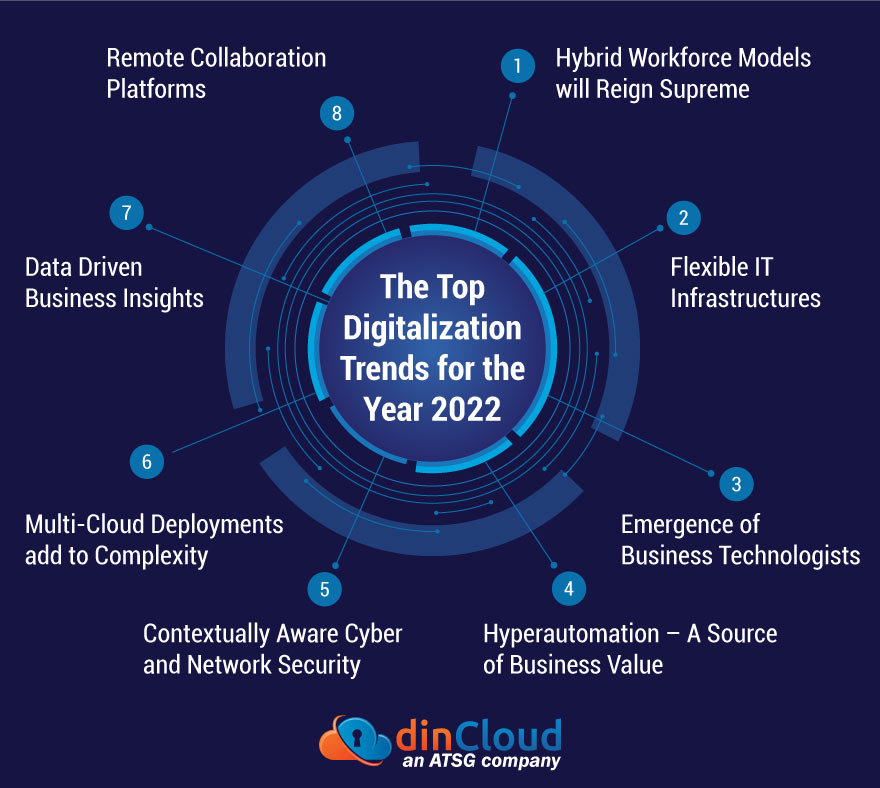A good part of the year 2021 has been all about digitalization. As soon as businesses stabilized themselves from the devastation of the pandemic, the first thing on the minds of their management was a move towards rapid digitalization.
In this post, we will outline some of the top digitalization trends that are likely to dominate over the upcoming year 2022. It is quite evident from these trends that digitalization will be showing no signs of slowing down, and enterprises will have to catch up really fast.

Related: Gartner’s Top Strategic Technology Trends for Year 2022
Hybrid Workforce Models will Reign Supreme
Over the past months, not only has the enterprise evolved in a big way, but so have employee expectations. The future of enterprise workloads lies in highly connected, hybrid work models, as there might never be a full on return to the physical workplace.
Flexible IT Infrastructures
The enterprise infrastructures are quite likely to pivot towards even more flexibility, which implies a more pronounced deployment of cloud services and solutions across the enterprise. These flexible infrastructures will deliver the agility that businesses need.
Emergence of Business Technologists
In addition to core business area experts, enterprises will need business technologists. The role of these professionals will be to weave modern digital technologies like the Cloud and Edge into core business processes in the most seamless manner possible.
Related: How are Cloud and Tech Reviving the Travel Industry?
Hyperautomation – A Source of Business Value
In the pursuit of an emerging need for flexibility and agility, hyperautomation within enterprises will become the norm. This in turn will improve the efficiency of business processes, while also reducing the time it takes to roll out new products and services.
Contextually Aware Cyber and Network Security
Due to the aspects of workload automation and remote employees, network and cyber security mechanisms will have to be dynamic, and contextually aware. These controls will have to take into account both the user’s actions, and the underlying intent.
Related: How Does Cloud Bursting Work and Its Pros n Cons?
Multi-Cloud Deployments add to Complexity
While the benefits of multi cloud are quite compelling for enterprises, such deployments will nonetheless add to infrastructural and management related complexities. Enterprises will have to come up with the right tools, and knowledge workers to pull this off.
Related: The Impact of Cloud Computing on Technology Evolution
Data Driven Business Insights
Going forward, the success of businesses will hinge on their ability to better govern their data, and extract actionable business insights from this data that have both factual as well as contextual relevance.
Remote Collaboration Platforms
Amidst the widely prevalent trend of remote and hybrid work models, remote collaboration platforms will remain extremely relevant. However, only the platforms with the right set of cyber security and data privacy mechanisms in place need to be considered by enterprises.
Conclusion
Some of the digitalization trends cited above for the upcoming year 2022 might be useful, while others could even be indispensable for enterprises. One thing is for sure though, digitalization is becoming imperative for businesses across the globe.
When we talk of digitalization and digital technologies, Cloud Computing emerges as the binding factor among most of them. Instead of going full blown multi cloud though, we recommend taking a measured approach towards the start, and then build on.
Contact dinCloud for some of the most reliable, secure and cost efficient cloud solutions for your enterprise needs.


